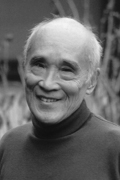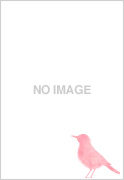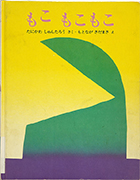- Top
- > Japanese Authors of Children's Literature: A Special-Feature Section of Outstanding Authors
Japanese Authors of Children's Literature: A Special-Feature Section of Outstanding Authors
- Momoko
Ishii - Mimei
Ogawa - Shuntaro
Tanikawa - Kenji
Miyazawa - Nankichi
Niimi - Masamoto
Nasu

Photograph taken by Ichiro Kikuchi
Shuntaro Tanikawa
1931-2024 List of books
The words of Shuntaro Tanikawa, whose first collection of poetry is Nijuoku konen no kodoku [Two billion light-years of solitude], eventually reached out to young readers. Whether writing original poetry, picture books, and stories or translating the works of others into Japanese, he continued to unearth rich and deep literary expressions of childhood.
Tanikawa grew up in Tokyo as the only child of philosopher Tetsuzo Tanikawa and his wife, Takiko, who was a graduate of a music conservatory. He began writing poetry while a student of the Tokyo Metropolitan Toyotama high school, at which time he felt uncomfortable at school. His debut as a poet occurred the same year he graduated from high school, when the collection of poems Nero hoka gohen [Nero, and other five poems] was published in Bungakukai [Literary world] magazine at the recommendation of his father’s friend, the poet Tatsuji Miyoshi. In 1952, he published his first book of poetry, Nijuoku konen no kodoku [Two billion light-years of solitude]. In the poem Nero from his debut work, the poet describes the end of childhood while addressing Nero, a puppy who had died. Several poems in this first collection describe with undisguised emotion the loneliness and sadness of being born a small creature in a vast universe.
As a poet, Tanikawa carried on publishing collections of poems while publishing children’s books including Ken wa hecchara [Ken is unfazed] (1965), which is a story for children, the picture book Koppu [Glasses] (1972), and the poetry collection Kotoba asobi uta [Word games: Nonsense pictures and rhymes] (1973). He also translated various works into Japanese, including all five volumes of Maza gusu no uta [The songs of Mother goose] (1975–76) and Leo Lionni’s picture book, Swimmy (1969). His poetic prose greatly expanded the potential of children’s literature.
Tanikawa wrote Kotoba asobi uta [Word games: Nonsense pictures and rhymes], Warabe uta [Nursery songs] (1981), and Mimi wo sumasu [Listening] (1982) as well as other works of both poetry and prose in Hiragana only. Thus, children can enjoy reading the text out loud and deepening their understanding themselves. At the same time, his works stand in stark contrast to contemporary poetry, which is no longer something to be read aloud and has thereby lost its aural presence. Shuntaro Tanikawa’s works seem to become more sophisticated over time through his contact with other children’s books and their young readers.
C-3-1Nijuoku konen no kodoku [Two billion light-years of solitude]
Written by Shuntaro Tanikawa
Sanrio 1992
Call No. KH591-E12 (First ed. 911.56-Ta881n)
The first edition of this first anthology of poetry by Shuntaro Tanikawa was published in 1952 by Sogensha. The poems were written between the winter of 1949 and the spring of 1951. Twenty-one poems that were not compiled in the first edition were included as Nijuoku konen no kodoku shui [Anthology of poems from two billion light-years of solitude].
C-3-2Utsumuku seinen: shishu [Looking down: selected poems]
Written by Shuntaro Tanikawa
Sanrio 1990
Call No. KH591-E5 (First ed. KH591-3)
The first edition of this work was published in 1971. According to the postscript, “this collection was selected from poems that had been written upon request from newspapers and magazines,” and was instrumental in exposing his works to a larger audience.
C-3-3Hadaka: Tanikawa Shuntaro shishu [Naked: Poems by Shuntaro Tanikawa]
Written by Shuntaro Tanikawa
Chikumashobo 1988
Call No. KH591-E2
This is a collection of poems written in hiragana about children's experiences and their inner world. Illustrated by Yoko Sano.
C-3-4Nihongo [Japanese language]
Edited by Mitsumasa Anno and others
Fukuinkan Shoten 1979
Call No. Y7-7782
This book is described as a “Japanese textbook for first graders that is not constrained by Ministry of Education, Science, Sports and Culture guideline.” It includes contributions from Mitsumasa Anno, Makoto Ooka, and Tadashi Matsui, but the text was written primarily by Shuntaro Tanikawa.
C-3-5Warabe uta, jo [Nursery songs, volume one]
Edited by Shuntaro Tanikawa
Fuzambo 1982
Call No. Y8-245
Translating Mother Goose into Japanese led to a reevaluation of traditional Japanese nursery songs, which the author attempted to revive in a picture book. The book was designed and illustrated by Seiichi Horiuchi.
C-3-6Warabe uta [Nursery songs]
Written by Shuntaro Tanikawa
Shueisha 1981
Call No. KH591-18
This is a collection of contemporary warabe uta (nursery songs) that resulted from a desire to write new poems based on the everyday lives of children, which would make children want to sing out loud.
C-3-7Mimi wo sumasu [Listening]
Written by Shuntaro Tanikawa
Fukuinkan Shoten 1982
Call No. Y7-9888
This book contains six long hiragana poems, intended to be read aloud. The poems are written in hiragana so that readers will recite them slowly. The book is designed and illustrated by Gen'ichiro Yagyu.
C-3-8Dokin: Tanikawa Shuntaro shonen shishu [Heart beat: Poems for children by Shuntaro Tanikawa]
Written by Shuntaro Tanikawa/Illustrated by Makoto Wada
Rironsha 1983
(Shi no sanpomichi [Poetry promenade])
Call No. Y8-459
This is the author’s first anthology of poetry for children, in which the text is harmonized with monochrome line drawings. The book contains fifty-three poems including works such as “Ishikkoro” [Pebbles] and “Unko” [Poop], written from a child’s perspective.
![Thumbnail of Ichinensei [The first grader]](img/t_image_person03_09.jpg)
C-3-9Ichinensei [The first grader]
Written by Shuntaro Tanikawa/Illustrated by Makoto Wada
Shogakukan 1988
Call No. Y18-2973
This is an anthology of poetry for first graders, which depicts elements from the daily life of a child, such as “Aishiteru” [I love you], “Warukuchi” [Bad-mouthing] and “Pan” [Bread]. Twenty-three poems are included.
C-3-10Kore wa nomi no Piko [This is Piko the flea]
Written by Shuntaro Tanikawa/Illustrated by Makoto Wada
Sanrido 1989
Call No. Y17-N00-249
This tale is a cumulative song inspired by the author translating “The house that Jack built” from Mother Goose nursery rhymes. The first edition was published in 1979.
C-3-11Ken wa hecchara [Ken is unfazed]
Written by Shuntaro Tanikawa/Illustrated by Makoto Wada
Akane Shobo 1965
(Sosaku dowa ehon [Picture book of original children's stories] 7)
Call No. Y17-35-[7]
This is the author’s first dowa (children's story), which was published when his eldest son Kensaku was five years old. It is also the author’s second collaborative work with illustrator Makoto Wada, following on the privately published Shiritori [Word chain game] and tells the story of a young boy who starts out with a piece of string in his pocket but eventually barters his way into a pistol.
C-3-12Shino wa kyoro kyoro [Shino is looking around]
Written by Shuntaro Tanikawa/Illustrated by Makoto Wada
Akane Shobo 1969
(Nihon no sosaku yonen dowa [Japanese original young children's stories] 9)
Call No. Y7-1458
Shino, a five-year old girl, explores different places inside a department store and returns to her mother. The story blends fantasy and reality from the perspective of a child, with an ear-catching text.
C-3-13Wahha Wahhahai no boken [Adventure of Wahha Wahhahai]
Written by Shuntaro Tanikawa/Illustrated by Makoto Wada
Kodansha 1971
(Kodansha no sosaku dowa [Kodansha’s original children's stories] 10)
Call No. Y7-2832
This collection of dowa (children's stories) for younger readers features a main character called ‘Wahha Wahhahai,’ who was born in Getageta on Topisuca Island. The prosaic rather than poetic nature of the text imbues the story with humor and interest.
C-3-14Koppu [Glasses]
Written by Shuntaro Tanikawa/Photographs by Masaaki Imamura/Art direction by Hiroshi Kusaka
Fukuinkan Shoten 1976
(Hajimete deau kagaku ehon [The first science picture book])
Call No. Y11-828
This is a scientific picture book that introduces the features and usage of a drinking glass through humorous text and photographs. Tanikawa later indicated that the drinking glass was intended to symbolize his own self. First appeared in Kagaku no tomo [Children's science companion] No. 35 (1972).
C-3-15Moko mokomoko
Written by Shuntaro Tanikawa/Illustrated by Sadamasa Motonaga
Bunken Shuppan [1977]
(Miru miru ehon [Look look picture book])
Call No. Y17-5294
A book of nonsense depicted in abstract pictures with mimetic and onomatopoeic expressions in Japanese, such as “moko” and “pachin.” While some adults find this book to be incomprehensible, it has never gone out of print due to its popularity with children.
C-3-16Hitori [Alone]
Written by Shuntaro Tanikawa/Illustrated by Shigeru Miwa
Barunsha 1982
(Shirizu, Chiisana tsubuyaki [Series, Small tweets])
Call No. Y17-9386
The main character’s insistent claim that there is nothing wrong with being alone is all the more prominent thanks to a text written in both Japanese and English and unsentimental illustration.
C-3-17Futago no ki [The twin trees]
Photographs by Kazuma Anezaki/Written by Shuntaro Tanikawa
Shobo "Ki" 1982
Call No. Y17-9398
A variety of photographs of varying ambience and coloration taken at different times of day and seasons are used to provide a deeply intriguing account of a conversation between two trees.
C-3-18Ana [Digging the hole]
Written by Shuntaro Tanikawa/Illustrated by Makoto Wada
Fukuinkan Shoten 1983
(Kodomo no tomo Kessakushu [Masterpieces of Children's companion])
Call No. Y17-9297
The main character creates “his own hole” in the ground, from where he discovers a different view of the world. The simplicity of the illustrations conveys to the reader an idea of just how “deep and dark” living in one’s own world can be.

C-3-19Kawa [The river]
Photographs by Toshinobu Takeuchi/Written by Shuntaro Tanikawa
Seibundo Shinkosha 1984
(Shashin ehon [Picture book of photographs])
Call No. Y18-820
Takeuchi is an expert in scenic photography, and his photographs speak eloquently of poetic scenes that trace the path of a river from its headwaters, along its course, and down to its confluence.
C-3-20Yoru no byoin [In the night hospital]
Written by Shuntaro Tanikawa/Photographs by Shigeichi Nagano
Fukuinkan Shoten 1985
(Kodomo no tomo Kessakushu [Masterpieces of Children's companion])
Call No. Y18-966
This story first appeared in Kodomo no tomo [Children's companion] no. 282 (1979). An emergency operation at a hospital during the middle of the night is depicted dramatically through monochrome photographs.

C-3-21Ippon no enpitsu no muko ni [Beyond a pencil]
Written by Shuntaro Tanikawa/Photographs by Nobuhiko Sakai and others/Illustrated by Seiichi Horiuchi
Fukuinkan Shoten 1989
(Takusan no fushigi Kessakushu [Masterpieces of A world of wonders])
Call No. Y1-1270
This story first appeared in Takusan no fushigi [A world of wonders] no. 1 (1985). It portrays the daily lives of people involved in the manufacture of pencils. It also includes the poem Nakushita enpitsu [The lost pencil] by Yaso Saijo. The book layout is by Seiichi Horiuchi.
C-3-22Mamadesu suki desu suteki desu [A book of word game]
Written by Shuntaro Tanikawa/Illustrated by Tiger Tateishi
Fukuinkan Shoten 1992
(Yoji ejon sirizu [Infant’s picture book series])
Call No. Y18-6520
This story first appeared in Kodomo no tomo nenshoban [Younger children's companion] no. 115 (1986). It is written in the style of a word-chain game. Illustrations by Tiger Tateishi make this an enjoyable story.
C-3-23Arekusanda to zenmai nezumi: Tomodachi wo mitsuketa nezumi no hanashi [Alexander and the wind-up mouse]
Written and illustrated by Leo Lionni/Translated by Shuntaro Tanikawa
Kogakusha [1975]
Call No. Y17-4474
In this picture book, Alexander the mouse becomes jealous of a wind-up toy mouse. It is illustrated by Leo Lionni's skillful collage techniques.
C-3-24Ojiichan [Granpa]
Written and illustrated by John Burningham/Translated by Shuntaro Tanikawa
HOLP SHUPPAN, Publishing 1985
Call No. Y18-1412
Time goes by and the seasons change from spring to winter as grandpa and his granddaughter spend their days peacefully. This story offers a positive depiction of death.
C-3-25Aru getsuyobi no asa [One Monday morning]
Written and illustrated by Uri Shulevitz/Translated by Shuntaro Tanikawa
Tokuma Shoten 1994
Call No. Y18-10292
On Monday, the King, the Queen and the little Prince came to visit. On Tuesday, their attendants continued to increase. What will happen by Sunday? An imaginary world expands across the everyday life of a city.
C-3-26Maza gusu besuto (dai 1, 2, 3 shu) [The best of 'The songs of mother goose' (3 volumes)]
Translated by Shuntaro Tanikawa/Illustrated by Seiichi Horiuchi
Soshisha Publishing 2000
Call No. KS164-G815
This collection contains one hundred famous rhymes, selected from the five volumes of Maza-gusu no uta [The songs of mother goose] (published by Soshisha from 1975 to 1976). This book introduced traditional English nursery rhymes to the Japanese public, accompanied with innovative illustrations by Seiichi Horiuchi. Shown here is the cover of vol. 1.
![Thumbnail of Sunupi no sukuru deizu [A Peanuts book featuring Snoopy for school children]](img/t_image_person03_27.jpg)
C-3-27Sunupi no sukuru deizu [A Peanuts book featuring Snoopy for school children]
Written and illustrated by Charles Monroe Schulz/Translated by Shuntaro Tanikawa
Kadokawa Shoten 2010
(Kadokawa tsubasa bunko [Kadokawa wing library])
Call No. Y16-N10-J30
A comic strip that depicts the daily school life of the Peanuts characters. Since Pinatsu bukkusu [Peanuts books] first appeared in Japan in 1969, these stories of Charlie Brown, Snoopy, and their friends have been loved by many.
C-3-28Tetsuwan Atomu [Astro boy]
Written by Shuntaro Tanikawa
Tanikawa Shuntaro: Tanikawa Shuntaro varaeti bukku konnichiwa [Shuntaro Tanikawa: Shuntaro Tanikawa’s variety book “Hello”]
Magazine House 1999
(Magazine House mook.Brutus toshokan [Brutus library])
Call No. KH591-G14
Shuntaro Tanikawa wrote the lyrics for the theme song of Japan's first domestically-produced television cartoon series, created by Osamu Tezuka and broadcast from 1963 to 1966. Even today, this song is covered by other artists and appears in many places.


![Thumbnail of Nijuoku konen no kodoku [Two billion light-years of solitude]](img/t_image_person03_01.jpg)
![Thumbnail of Utsumuku seinen: shishu [Looking down: selected poems]](img/t_image_person03_02.jpg)
![Thumbnail of Hadaka: Tanikawa Shuntaro shishu [Naked: Poems by Shuntaro Tanikawa]](img/t_image_person03_03.jpg)
![Thumbnail of Nihongo [Japanese language]](img/t_image_person03_04.jpg)
![Thumbnail of Warabe uta, 1 [Nursery songs, volume one]](img/t_image_person03_05.jpg)
![Thumbnail of Warabe uta [Nursery songs]](img/t_image_person03_06.jpg)
![Thumbnail of Mimi wo sumasu [Listening]](img/t_image_person03_07.jpg)
![Thumbnail of Dokin: Tanikawa Shuntaro shonen shishu [Heart beat: Poems for children by Shuntaro Tanikawa]](img/t_image_person03_08.jpg)
![Thumbnail of Kore wa nomi no Piko [This is Piko the flea]](img/t_image_person03_10.jpg)
![Thumbnail of Ken wa hecchara [Ken is unfazed]](img/t_image_person03_11.jpg)
![Thumbnail of Shino wa kyoro kyoro [Shino is looking around]](img/t_image_person03_12.jpg)
![Thumbnail of Wahha Wahhahai no boken [Adventure of Wahha Wahhahai]](img/t_image_person03_13.jpg)
![Thumbnail of Koppu [Glasses]](img/t_image_person03_14.jpg)

![Thumbnail of Hitori [Alone]](img/t_image_person03_16.jpg)
![Thumbnail of Futago no ki [The twin trees]](img/t_image_person03_17.jpg)
![Thumbnail of Ana [Digging the hole]](img/t_image_person03_18.jpg)
![Thumbnail of Yoru no byoin [In the night hospital]](img/t_image_person03_20.jpg)
![Thumbnail of Mamadesu suki desu suteki desu [A book of word game]](img/t_image_person03_22.jpg)
![Thumbnail of Arekusanda to zenmai nezumi: Tomodachi wo mitsuketa nezumi no hanashi [Alexander and the wind-up mouse]](img/t_image_person03_23.jpg)
![Thumbnail of Ojiichan [Granpa]](img/t_image_person03_24.jpg)
![Thumbnail of Aru getsuyobi no asa [One Monday morning]](img/t_image_person03_25.jpg)
![Thumbnail of Maza gusu besuto (dai 1, 2, 3 shu) [The best of 'The songs of mother goose' (3 volumes)]](img/t_image_person03_26.jpg)
![Thumbnail of Tetsuwan Atomu [Astro boy]](img/t_image_person03_28.jpg)


















